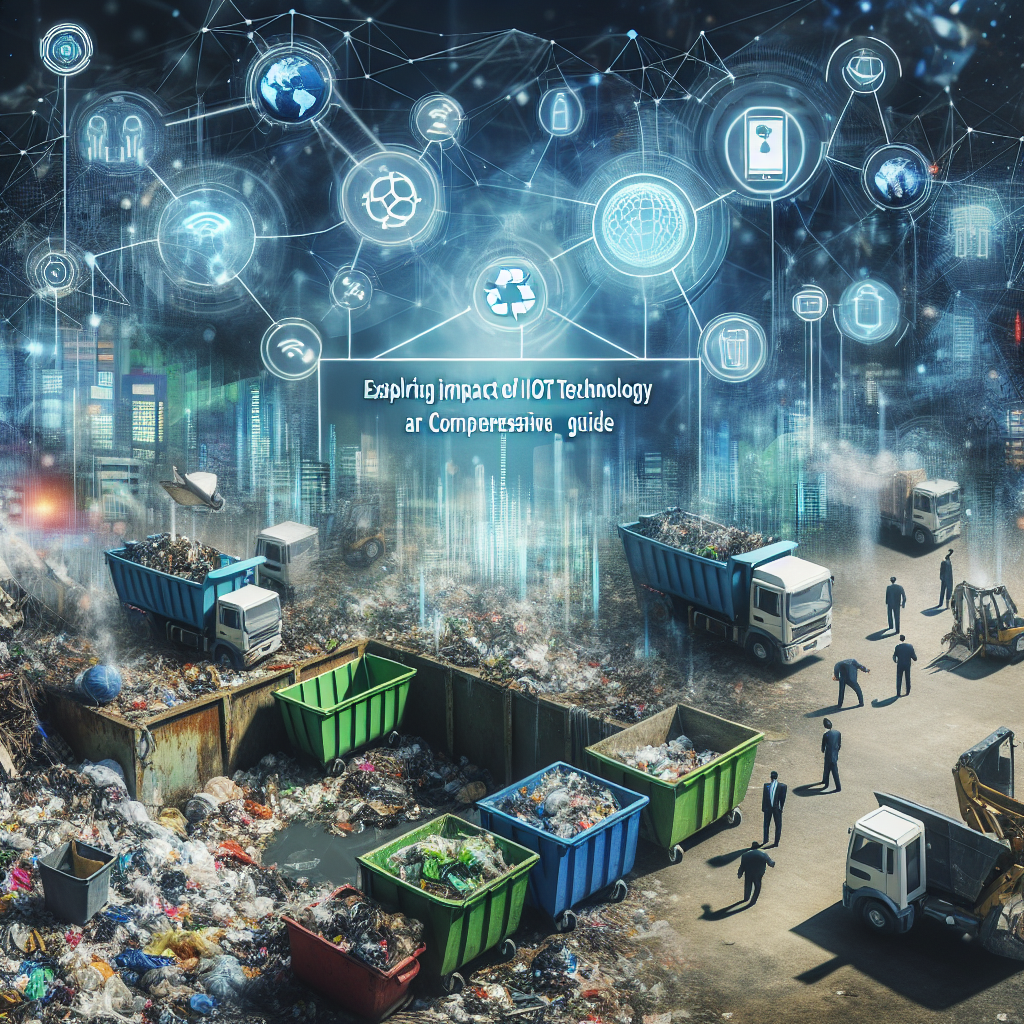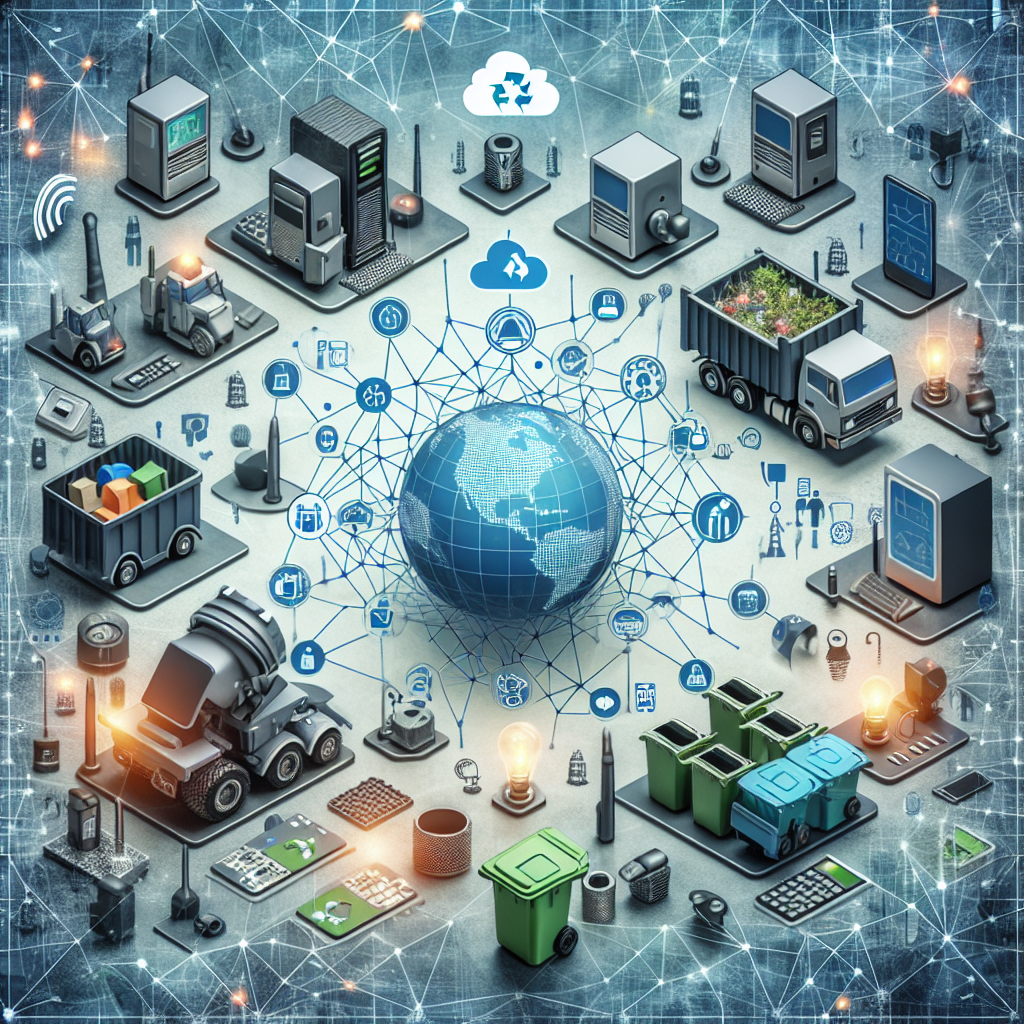In today’s fast-paced world, the Internet of Things (IoT) technology has revolutionized various industries, including waste management. This comprehensive guide delves into the impact of IoT technology on waste management, highlighting its potential to streamline operations, optimize resource allocation, and enhance sustainability efforts. From smart waste bins that automatically signal when they need to be emptied to real-time monitoring systems that track waste levels, IoT solutions are transforming the way we manage and dispose of waste. Join us on a journey to explore the potential of IoT technology in revolutionizing waste management practices for a greener, more efficient future.
Understanding IoT Technology in Waste Management

In the realm of waste management, the integration of Internet of Things (IoT) technology has revolutionized traditional waste disposal methods, paving the way for more efficient and sustainable practices. By leveraging IoT solutions, waste management processes can be optimized through real-time monitoring, data analytics, and predictive maintenance strategies. Understanding the intricacies of IoT technology in waste management is essential for harnessing its full potential.
- Definition of IoT in Waste Management
-
IoT in waste management refers to the utilization of interconnected devices and sensors to collect and transmit data related to waste generation, collection, sorting, and disposal. These devices communicate with each other and with centralized systems to enable automated decision-making and streamline waste management operations.
-
Key Components of IoT Technology
-
Data Sensors: IoT devices in waste management are equipped with various sensors to capture data on fill levels, temperature, humidity, and other relevant parameters. These sensors provide real-time information that enables waste management companies to optimize collection schedules, reduce operational costs, and enhance overall efficiency.
-
Connectivity Options: IoT devices rely on different connectivity options such as Wi-Fi, cellular networks, and LPWAN (Low Power Wide Area Network) to transmit data to centralized platforms. This connectivity enables seamless communication between devices, cloud-based applications, and monitoring systems, facilitating remote management and control of waste management processes.
-
Data Analytics: The data collected by IoT devices is processed and analyzed using advanced analytics tools to derive actionable insights for decision-making. By leveraging data analytics, waste management companies can identify trends, predict waste generation patterns, detect anomalies, and optimize resource allocation, leading to improved operational performance and sustainability outcomes.
Benefits of Implementing IoT in Waste Management
- Enhanced Efficiency
Implementing IoT technology in waste management processes significantly enhances efficiency by automating various tasks such as waste collection scheduling, route optimization, and bin monitoring. Through sensors and data analytics, waste management companies can optimize collection routes based on real-time data on fill levels, ensuring that trucks are deployed only when bins are full. This automation reduces unnecessary trips and idle time, leading to more efficient operations and cost savings.
- Cost-Effectiveness
IoT technology helps in reducing operational costs by optimizing resource allocation and streamlining waste collection processes. With real-time monitoring of waste levels in bins, companies can avoid overflowing bins, which can lead to additional costs for cleanup and potential fines. By accurately predicting waste generation patterns, organizations can adjust collection schedules and routes, minimizing fuel consumption and labor hours. Additionally, predictive maintenance enabled by IoT sensors can prevent equipment breakdowns, reducing repair costs and downtime.
- Improved Sustainability
The implementation of IoT in waste management promotes sustainability by enabling better waste segregation, recycling, and resource recovery. By tracking the types and quantities of waste generated in different locations, organizations can tailor recycling programs to maximize diversion from landfills. IoT sensors can also help monitor composting processes, ensuring optimal conditions for organic waste decomposition and reducing greenhouse gas emissions. This targeted approach to waste management contributes to environmental conservation and supports circular economy principles.
- Real-Time Monitoring and Management
One of the key benefits of IoT technology in waste management is the ability to monitor operations in real time, allowing for proactive decision-making and swift responses to issues. By receiving instant alerts on bin fill levels, temperature variations, or equipment malfunctions, waste management companies can address issues promptly, preventing service disruptions and maintaining operational continuity. Real-time data insights also enable better planning for future waste collection needs, improving overall service quality and customer satisfaction.

Challenges in Adopting IoT for Waste Management
Implementing IoT technology in waste management processes presents several challenges that organizations need to address to fully leverage its benefits:
- Initial Investment Costs
The deployment of IoT devices and infrastructure requires a significant upfront investment. Companies may need to invest in sensors, connectivity solutions, data analytics platforms, and staff training to effectively implement IoT in waste management operations. The high initial costs can be a barrier for some organizations, especially smaller waste management companies with limited financial resources.
- Data Security Concerns
IoT devices collect and transmit large amounts of data, including sensitive information about waste volumes, collection schedules, and operational efficiencies. Ensuring the security and privacy of this data is crucial to prevent unauthorized access, data breaches, and potential disruptions to waste management processes. Organizations must implement robust cybersecurity measures, encryption protocols, and access controls to protect IoT-generated data from potential threats.
- Integration with Existing Systems
Integrating IoT technology with existing waste management systems and processes can be a complex and challenging task. Many organizations struggle to seamlessly connect IoT devices with legacy infrastructure, software applications, and operational workflows. Compatibility issues, data interoperability challenges, and the need for system upgrades or modifications can hinder the smooth integration of IoT technology into waste management operations.
- Training and Skill Development
Adopting IoT technology in waste management requires employees to acquire new skills and knowledge to effectively utilize IoT devices and data analytics tools. Training staff on how to operate and maintain IoT systems, interpret data insights, and make informed decisions based on IoT-generated information is essential for successful implementation. Upskilling employees and providing ongoing training programs are critical to overcoming the skills gap and ensuring the efficient use of IoT technology in waste management practices.
Case Studies Highlighting Successful IoT Implementation
City-wide Waste Management Systems
- In Barcelona, Spain, IoT technology has been integrated into the city’s waste management system to optimize waste collection routes based on real-time data.
- Sensors installed in waste containers transmit information on fill levels, allowing for efficient scheduling of collection trucks and reducing unnecessary trips.
- This implementation has resulted in significant cost savings for the city while simultaneously improving waste collection efficiency.
Smart Bins in Urban Areas
- Singapore has deployed smart bins equipped with IoT sensors to monitor waste levels and send alerts when they are nearing full capacity.
- These bins are strategically placed in high-traffic areas, reducing overflow and ensuring timely waste collection.
- The data collected from these smart bins is used to analyze waste generation patterns, leading to better waste management strategies and resource allocation.
Waste Sorting and Recycling Facilities
- In Sweden, IoT technology has been utilized in waste sorting and recycling facilities to automate processes and increase recycling rates.
- Sensors are integrated into conveyor belts to sort different types of waste efficiently, reducing contamination and improving the quality of recyclable materials.

- This implementation has not only enhanced recycling efforts but has also led to a reduction in landfill waste, contributing to a more sustainable waste management ecosystem.
Future Trends in IoT Technology for Waste Management
In the realm of waste management, the integration of IoT technology is paving the way for innovative solutions to streamline processes and optimize resource utilization. Looking ahead, several key trends are emerging that hold significant promise for the future of waste management:
-
Artificial Intelligence Integration
-
The integration of artificial intelligence (AI) algorithms into IoT waste management systems enables real-time data analysis and decision-making. AI can identify patterns in waste generation, optimize collection routes, and even predict equipment maintenance needs, ultimately enhancing operational efficiency and cost-effectiveness.
-
Blockchain for Transparent Waste Tracking
-
Blockchain technology is revolutionizing waste tracking by providing a secure and transparent platform for recording and verifying waste management transactions. By leveraging blockchain, stakeholders can trace the journey of waste from generation to disposal, ensuring accountability, reducing fraud, and promoting sustainable practices.
-
Predictive Analytics for Waste Generation
-
Predictive analytics powered by IoT devices offer valuable insights into waste generation patterns, enabling proactive planning and resource allocation. By analyzing historical data and environmental factors, waste management systems can forecast future waste volumes, optimize recycling programs, and minimize landfill usage, contributing to a more sustainable and efficient waste management ecosystem.
Recommendations for Businesses and Municipalities
In the realm of waste management, the integration of IoT technology offers a myriad of benefits and opportunities for businesses and municipalities alike. To effectively harness the potential of IoT in waste management, the following recommendations are crucial:
- Conducting Cost-Benefit Analysis
Before embarking on any IoT implementation in waste management, businesses and municipalities should conduct a comprehensive cost-benefit analysis. This analysis should consider factors such as initial investment costs, potential savings in operational expenses, and the long-term benefits of improved efficiency and sustainability. By evaluating the financial implications upfront, organizations can make informed decisions regarding the feasibility and viability of IoT adoption in waste management.
- Investing in Secure IoT Infrastructure
One of the fundamental aspects of integrating IoT technology in waste management is ensuring the security and integrity of the infrastructure. Businesses and municipalities should prioritize investing in robust and secure IoT systems that can safeguard sensitive data and prevent cyber threats. Implementing encryption protocols, access controls, and regular security updates are essential measures to protect the IoT ecosystem from potential vulnerabilities and breaches.
- Partnering with Tech Experts for Implementation
Given the complexity of IoT solutions in waste management, businesses and municipalities are encouraged to collaborate with tech experts and industry specialists for the successful implementation of IoT initiatives. Partnering with experienced vendors and consultants can provide valuable insights, technical expertise, and support throughout the deployment process. These partnerships can streamline project execution, mitigate risks, and ensure the effective utilization of IoT technology to optimize waste management operations.
- Continuous Monitoring and Adaptation
IoT technology is dynamic and continuously evolving, requiring businesses and municipalities to prioritize continuous monitoring and adaptation of their waste management systems. By leveraging real-time data insights and analytics generated by IoT devices, organizations can proactively identify inefficiencies, optimize processes, and make data-driven decisions to enhance overall performance. Regular monitoring of key performance indicators, system performance metrics, and user feedback is essential to drive continuous improvement and innovation in waste management practices.
FAQs: Exploring the Impact of IoT Technology on Waste Management
What is IoT technology and how does it relate to waste management?
Internet of Things (IoT) technology refers to the network of devices, sensors, and software that are connected and communicate with each other to collect and exchange data. In the context of waste management, IoT technology can be utilized to monitor, track, and optimize waste collection and disposal processes. By using IoT devices such as smart bins and sensors, waste management companies can gather real-time data on waste levels, bin locations, and operational efficiency, leading to improved waste management practices.
What are some benefits of integrating IoT technology into waste management processes?
Integrating IoT technology into waste management processes offers numerous benefits, including increased operational efficiency, optimized waste collection routes, reduced costs, and improved monitoring and reporting capabilities. By using IoT devices, waste management companies can streamline their operations, minimize unnecessary trips, and proactively address potential maintenance issues, leading to a more sustainable and effective waste management system.
How can IoT technology help in reducing environmental impact and promoting sustainability in waste management?
IoT technology can help in reducing environmental impact and promoting sustainability in waste management by enabling more efficient waste collection and disposal practices. By using IoT devices to monitor waste levels, companies can optimize collection routes, reduce fuel consumption, and minimize emissions. Additionally, IoT technology allows for better waste segregation and recycling efforts, leading to increased environmental sustainability and reduced landfill usage.
What are some challenges and limitations of implementing IoT technology in waste management?
Some challenges and limitations of implementing IoT technology in waste management include the initial cost of investment, potential cybersecurity risks, and the need for technical expertise to maintain and troubleshoot the IoT devices. Additionally, compatibility issues with existing waste management systems and the necessity for reliable network connectivity in remote areas can pose obstacles to the seamless integration of IoT technology in waste management operations.
How can waste management companies effectively integrate IoT technology into their existing processes?
To effectively integrate IoT technology into their existing processes, waste management companies should start by conducting a thorough assessment of their current operations and identifying areas where IoT devices can be utilized to improve efficiency and sustainability. Companies should also invest in training their staff on how to use and maintain IoT devices, as well as develop clear communication protocols for data collection and analysis. By carefully planning and implementing IoT technology, waste management companies can maximize the benefits of this innovative technology in their operations.